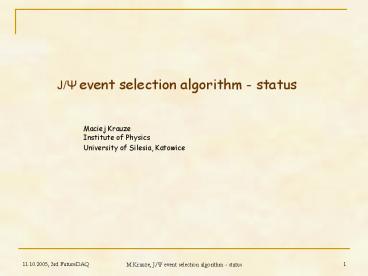J Trigger Parameter Simulation - PowerPoint PPT Presentation
1 / 8
Title:
J Trigger Parameter Simulation
Description:
University of Silesia, Katowice. 11.10.2005, 3rd FutureDAQ ... Requirements of the method. fast because we measure at the full beam luminosity ... – PowerPoint PPT presentation
Number of Views:64
Avg rating:3.0/5.0
Title: J Trigger Parameter Simulation
1
J/? event selection algorithm - status
Maciej KrauzeInstitute of Physics University of
Silesia, Katowice
2
Motivations
- there are many background events due to very low
J/? multiplicity - reduction of the number of events
- in order to make it possible to store the data
- to make the online analysis feasible
Requirements of the method
- fast ? because we measure at the full beam
luminosity - using as less detector information as possible
(currently 3 stations of the Transition
Radiation Detector) - efficient ? to reduce the bulk of data passed to
the next level analysis system
3
Software tools
- UrQMD, Pluto, Geant ROOT
- as a software base, CBM framework package was
used this package incorporates TRD detectors
layout
The detector layout used in our studies
4
Why TRD can be usefull for background event
reduction
- it can provide information about the particles
trajectory and momentum (estimation!) - it can distinguish between ee- and hadrons (?,
p) - 95-99 of hadron rejection (depends on the
particles momentum) - the detector has large material budget so the the
multiple scattering process has an influence on
obtained results - not very high resolution
5
Event selection methods ideas
- to supress as many background events as possible
- to preserve the signal
How?
- the main selection critterion is the invariant
mass value - we take every 2 particles of unlike charge within
the same event and calculate the invariant mass
of the pair - for the J/? particles, the invariant mass of the
decay pair is 3.1 GeV/c2 - if the event does not contain any pairs of
invariant mass greater than 2 GeV/c2, it is
REJECTED
6
Transversal momentum cut
- removes low-energy particles from background
- removes some fraction of signal (depends on the
threshold value) - to perform it we need a magnetic field and a
method of momentum reconstruction
Further reduction of the number of particles
taken to the combinatorics (speed!)
- non-bending plane cut (Y)
7
Further reduction of the number of particles
taken to the combinatorics (continued)
- bending plane cut (X)
X
Target
Z
these two geometric cuts combined reject 75 of
secondaries while only 3 of signal is lost
TRD1 TRD2
1 m
8
Requirements of the method
- fast track finder (at present we consider ideal
tracks) - precise track fitter (Kalman Filter)
- momentum determination method (fast and precise)
Summary and next steps
- the algorithm has roughly 90 efficiency or more
(depends on the parameters used) - we have to consider realistic track finder
- one can use some additional cuts (Pt angle,
opening angle, momentum value etc.) - to achieve greater efficiency, it may be
necessary to use information from additional
detector(s)































